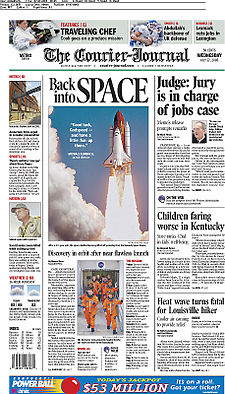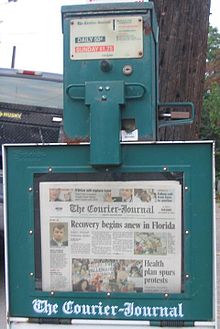- The Courier-Journal
-


The July 27, 2005 front page
of The Courier-JournalType Daily newspaper Format Broadsheet Owner Gannett Company, Inc. Publisher Arnold Garson Editor Bennie Ivory Founded 1868 Headquarters 525 West Broadway
Louisville, Kentucky 40201
 United States
United StatesCirculation 218,796 Daily
266,594 Sunday[1]Official website courier-journal.com The Courier-Journal, locally called "The C-J", is the main newspaper for the city of Louisville, Kentucky, USA. According to the 1999 Editor & Publisher International Yearbook, the paper is the 48th largest daily paper in the United States and the single largest in Kentucky.
Contents
History
Origins
The Courier-Journal was created from the merger of several newspapers introduced in Kentucky in the 1800s.
Pioneer paper The Focus of Politics, Commerce and Literature, was founded in 1826 in Louisville when the city was an early settlement of less than 7,000 individuals. In 1830 a new newspaper, The Louisville Daily Journal, began distribution in the city and, in 1832, absorbed The Focus of Politics, Commerce and Literature. The Journal was an organ of the Whig Party, founded and edited by George D. Prentice, a New Englander who initially came to Kentucky to write a biography of Henry Clay. Prentice would edit the Journal for more than 40 years.
In 1844, another newspaper, the Louisville Morning Courier was founded in Louisville by Walter Newman Haldeman. The Louisville Daily Journal and the Louisville Morning Courier were the news leaders in Louisville and were politically opposed throughout the Civil War; The Journal was against slavery while the Courier was pro-Confederacy. The Courier was suppressed by the Union and had to move to Nashville, but returned to Louisville after the war.
In 1868, an ailing Prentice persuaded the 28-year-old Henry Watterson to come edit to the Journal. During secret negotiations in 1868, The Journal and the Courier merged and the first edition of The Courier-Journal was delivered to Louisvillians on Sunday morning, 8 November 1868.
Watterson era
Henry Watterson, the son of a Tennessee congressman, had written for Harper's Magazine and the New York Times before enlisting in the Confederate Army. He became nationally known for his work as The Courier-Journal emerged as the region's leading paper. He supported the Democratic Party and pushed for the industrialization of Kentucky and the South in general, notably through urging the Southern Exposition be held in Louisville. He attracted controversy for attempting to prove that Christopher Marlowe had actually written the works of Shakespeare. He won a Pulitzer Prize in 1917 for editorials demanding the United States enter World War I.[2]
The Courier-Journal founded a companion afternoon edition of the paper, The Louisville Times, in May 1884. In 1896, Watterson and Haldeman opposed Democratic presidential candidate William Jennings Bryan over his support of "Free Silver" coinage. This unpopular decision upset readers and advertisers, many of whom pulled their support for The Courier-Journal. Kentucky voted for the Republican candidate in 1896, the first time in state history, and local political leaders blamed the Courier. Only the popularity of The Louisville Times, which had no strong editorial reputation, saved the newspaper company from bankruptcy. The Courier supported Bryan in future elections.[2]
Haldeman had owned the papers until his death in 1902, and by 1917 they were owned by his son, William, and Henry Watterson.
Bingham ownership
On August 8, 1918, Robert Worth Bingham purchased two-thirds interest in the newspapers and acquired the remaining stock in 1920. The liberal Bingham clashed with long-time editor Watterson, who remained on board, but was in the twilight of his career. Watterson's editorials opposing the League of Nations appeared alongside Bingham's favoring it, and Watterson finally retired on April 2, 1919.[2]
I have always regarded the newspapers owned by me as a public trust and have endeavored so to conduct them as to render the greatest public service.As publisher, Bingham set the tone for his editorial pages, and pushed for improved public education, support of African Americans and the poor of Appalachia. In 1933, the newspapers passed to his son, Barry Bingham, Sr. Barry Bingham would continue in his father's footsteps, guiding the editorial page and modernizing the paper by setting up several news bureaus throughout the state, expanding the news staff. During Barry Bingham, Sr.'s tenure, the paper was considered Kentucky's "Newspaper of Record" and consistently ranked among the 10 best in the nation.[2]
In 1971, Barry Bingham, Jr. succeeded his father as the newspapers' editor and publisher.
The Binghams were well-liked owners popularly credited with being more concerned with publishing quality journalism than making heavy profits. They also owned the leading local radio and television stations -- WHAS-TV, WHAS-AM, and WAMZ-FM -- and Standard Gravure, a rotogravure printing company that printed the Courier-Journal's Sunday Magazine as well as similar magazines for other newspapers.
Barry Bingham Jr. sought to free the papers from conflicts of interests, and through The Louisville Times, experimented with new ideas such as signed editorials. Bingham Jr. also parted with tradition by endorsing several Republican candidates for office.[2]
In 1974, Carol Sutton became managing editor of The Courier-Journal, the first woman appointed to such a post at a major US daily newspaper. Under the leadership of C. Thomas Hardin, director of photography, the combined photography staff of The Courier-Journal and Louisville Times was awarded the 1976 Pulitzer Prize for Feature Photography for its coverage of school desegregation in Louisville.
Barry Bingham, Jr. served as editor and publisher until he resigned in 1986, shortly after his father announced that the newspaper company was for sale, in large measure because of disagreements between Bingham Jr. and his sister Sallie.
Gannett ownership
In July 1986, Gannett Company, Inc. purchased the newspaper company for $300 million and appointed George N. Gill President and Publisher. Gill had been with the newspaper and the Binghams for over two decades, working his way up from reporter to Chief Executive Officer of the Bingham Companies. In 1993, Gill retired and Edward E. Manassah became President and Publisher.
In February 1987, publication of The Louisville Times, which like most afternoon papers had experienced declining readership, ceased after the news operations of the two papers had been consolidated under Gannett.
In 1989, The Courier-Journal's news staff won the Pulitzer Prize for general local reporting for what the Pulitzer board called "exemplary initial coverage" of a collision that was the nation's worst drunk-criving crash and school-bus accident. In 2005, cartoonist Nick Anderson won the paper's 10th Pulitzer, but when he left for the Houston Chronicle, the paper did not replace him, instead relying largely on submissions from local cartoonists. One, lawyer Marc Murphy, has become a near-regular and gained respect for his work.
As of 2005, the newspaper was read by an estimated 492,000 people daily and 670,900 people on Sundays.[3]
On December 3, 2008, it was announced that The C-J would lay off 51 employees, including 17 who voluntarily took buyout offers, as part of a larger cutback by Gannett due to financial losses.[4] On July 8, 2009 The Courier-Journal announced it would lay off 44 employees reducing the workforce to 575 employees.
The newspaper resumed polling on elections, and began videostreaming its editorial-board conferences with major candidates, under Publisher Arnold "Arnie" Garson, who came from the Argus Leader, Gannett's paper in Sioux Falls, S.D., in late 2008. Garson is an outspoken promoter of the future of printed newspapers in the digital age. Under him, the paper began keeping occasional major stories or sports columns off its website and promoting them as print exclusives. Most of these have run on Sundays; in July 2009, Garson announced that the paper's Sunday home-delivery circulation was up 0.5 percent over the previous year.
Awards
Pulitzer Prize
Year Category Recipient For 1918 Editorial Writing Henry Watterson For his two World War I editorials "War Has Its Compensation" (10 April 1918), and "Vae Victis" (17 May 1918). 1926 Reporting William Burke "Skeets" Miller For his coverage of the attempts to rescue Floyd Collins trapped in Sand Cave,
now part of Mammoth Cave National Park (February, 1925).1956 Editorial Cartooning Robert York For his cartoon "Achilles" showing a bulging figure of American prosperity tapering to a weak heel labeled "farm prices". Appeared in The Louisville Times, (16 September 1955). 1967 Public Service The Courier Journal For its "meritorious public service" during 1966 in its fight against the ravages of Kentucky strip mining. 1969 Local General or Spot News Reporting John Fetterman For coverage of the funeral for a Vietnam casualty from Kentucky, "PFC Gibson comes home" (28 July 1968). 1976 Feature Photography The Courier Journal and The Louisville Times For photo coverage of court-ordered busing in Jefferson County in 1975.
1978 Local General or Spot News Reporting Rich Whitt For his coverage and three months of investigation of the disastrous 28 May 1977 fire at the Beverly Hills Supper Club, Southgate, Kentucky in Campbell County. 1980 International Reporting Joel Brinkley and Jay Mather For international reporting in a series of articles, "Living the Cambodian Nightmare," their vivid account of refugees in Southeast Asia (December, 1979). 1989 General Reporting The Courier Journal For its exemplary initial coverage of a bus crash in Carroll County, Kentucky that claimed 27 lives and its subsequent thorough and effective examination of the causes and implications of the tragedy (1988). 2005 Editorial Cartoon Nick Anderson For his portfolio of twenty editorial cartoons.[5] See also
- Samuel C. Brightman, Courier-Journal reporter and Washington correspondent
- Kate Harrington (Poet), a former Courier-Journal reporter
References
- ^ "2007 Top 100 Daily Newspapers in the U.S. by Circulation" (PDF). BurrellesLuce. 2007-03-31. http://www.burrellesluce.com/top100/2007_Top_100List.pdf. Retrieved 2007-05-29.
- ^ a b c d e Towles, Donald B. (1994). The Press of Kentucky: 1787-1994. Kentucky Press Association. ASIN B0006P81OQ.
- ^ [1][dead link]
- ^ C-J lays off 51 as part of broader Gannett cutback The Courier-Journal. Retrieved on December 3, 2008.
- ^ "Nick Anderson- Pulitzer Prize Winner 2005". Web.archive.org. Archived from the original on 2005-11-29. http://web.archive.org/web/20051129224140/http://cagle.msnbc.com/news/PulitzerPrize2005/main.asp. Retrieved 2010-07-30.
Further reading
- Towles, Donald B. (1994). The Press of Kentucky: 1787-1994. Kentucky Press Association. ASIN B0006P81OQ.
- Pearce, John Ed (1997). Memoirs: 50 Years at the Courier-Journal and other places. Sulgrave Press. ISBN 1891138014.
External links
- The Courier-Journal website
- The Courier-Journal mobile website
- Gannett subsidiary profile of The Courier-Journal
Pulitzer Prize for Breaking News Reporting (1985–2000) - Thomas Turcol (1985)
- Edna Buchanan (1986)
- Akron Beacon Journal (1987)
- Alabama Journal/Lawrence Eagle-Tribune (1988)
- Louisville Courier-Journal (1989)
- San Jose Mercury News (1990)
- Miami Herald (1991)
- Newsday (1992)
- Los Angeles Times (1993)
- New York Times (1994)
- Los Angeles Times (1995)
- Robert D. McFadden (1996)
- Newsday (1997)
- Los Angeles Times (1998)
- Hartford Courant (1999)
- Denver Post (2000)
* From 1985 to 1990: Pulitzer Prize for General News Reporting; From 1991 to 1997: Pulitzer Prize for Spot News Reporting; From 1998 to present: Pulitzer Prize for Breaking News Reporting- Complete list
- (1985–2000)
- (2001–2025)
Categories:- Gannett publications
- Media in Louisville, Kentucky
- Newspapers published in Kentucky
- Publications established in 1868
- Pulitzer Prize winning newspapers
- Worth Bingham Prize recipients
Wikimedia Foundation. 2010.

